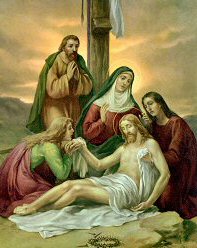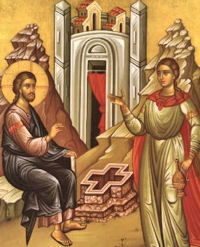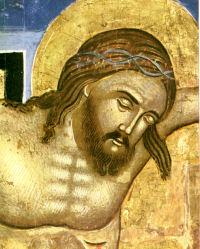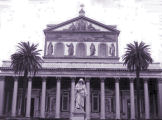| Nunraw March 2012 |
Night Office.
‘Fragrance’ word of St. Cyril of Alexandria.
At times the listening the Reading of the Second Nocturn suffers a deaf ear.
The only word picked up was ‘word’.
The about way of the Holy Spirit to prompted me back and read the lesson, -.
“offering himself to God the Father as a fragrant sacrifice for our sake,
“an appeasing fragrance, in the goat .., Christ is also symbolized...”,
“offering himself to God the Father as a fragrant sacrifice for our sake,
“an appeasing fragrance, in the goat .., Christ is also symbolized...”,
FIFTH SUNDAY OF LENT Year B
Gospel: John 12:20-33
“And when I am lifted up from the earth,
I shall draw all men to myself." (v33)
From a commentary on Numbers by Saint Cyril of Alexandria (Lib. 2: PG 69, 617-624)
Written sometime after 412, Cyril's "Glaphyra" or "polished explanations," from which this reading is taken, give an allegorical and typological exegesis of selected passages of the Pentateuch. This passage is a meditation on the mystery and paradox of Jesus' atoning death. It emphasizes our oneness with him. Christ, the grain of wheat that dies, is both the promise and sign of the future harvest.
As the firstfruits of our renewed humanity, Christ escaped the curse of the law precisely by becoming accursed for our sake. He overcame the forces of corruption by himself becoming once more free among the dead. He trampled death under foot and came to life again, and then he ascended to the Father as an offering, the firstfruits, as it were, of the human race. He ascended, as Scripture says, not to a sanctuary made by human hands, a mere copy of the real one, but into heaven itself, to appear in God's presence on our behalf He is the life-giving bread that came down from heaven, and by offering himself to God the Father as a fragrant sacrifice for our sake, he also delivers us from our sins and frees us from the faults that we commit through ignorance. We can understand this best if we think of him as symbolized by the calf that used to be slain as a holocaust and by the goat that was sacrificed for our sins committed through ignorance. For our sake, to blot out the sins of the world, he laid down his life.
Recognized then in bread as life and the giver of life, in the calf as a holocaust offered by himself to God the Father as an appeasing fragrance, in the goat as one who became sin for our sake and was slain for our transgressions, Christ is also symbolized in another way by a sheaf of grain, as a brief explanation will show.
The human race may be compared to spikes of wheat in a field, rising, as it were, from the earth, awaiting their full growth and development, and then in time being cut down by the reaper, which is death. The comparison is apt, since Christ himself spoke of our race in this way when he said to his holy disciples: Do you not say, "Four months and it will be harvest time?" Look at the fields I tell you, they are already white and ready for harvesting. The reaper is already receiving his wages and bringing in a crop for eternal life.
Now Christ became like one of us; he sprang from the holy Virgin like a spike of wheat from the ground. Indeed, he spoke of himself as a grain of wheat when he said: I tell you truly, unless a grain of wheat falls into the ground and dies, it remains as it was, a single grain; but if it dies its yield is very great. And so, like a sheaf of grain, the firstfruits, as it were, of the earth, he offered himself to the Father for our sake.
For we do not think of a spike of wheat, any more than we do of ourselves, in isolation. We think of it rather as part of a sheaf, which is a single bundle made up of many spikes. The spikes have to be gathered into a bundle before they can be used, and this is the key to the mystery they represent, the mystery of Christ who, though one, appears in the image of a sheaf to be made up of many, as in fact he is. Spiritually, he contains in himself all believers. As' we have been raised up with him, writes Saint Paul, so we have also been enthroned with him in heaven. He is a human being like ourselves, and this has made us one body with him, the body being the bond that unites us. We can say, therefore, that in him we are all one, and indeed he himself says to God, his heavenly Father: It is my desire that as I and you are one, so they also may be one in us.
| Nunraw Passiontide Tabernacle |























